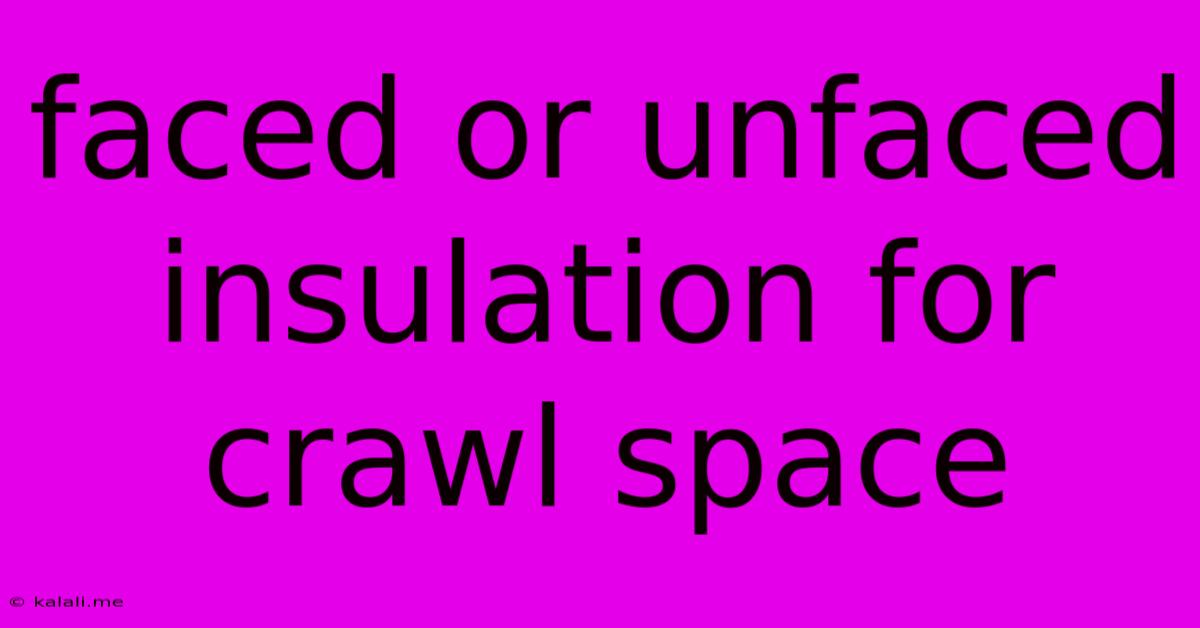Faced Or Unfaced Insulation For Crawl Space
Kalali
May 25, 2025 · 3 min read

Table of Contents
Faced vs. Unfaced Insulation for Crawl Spaces: Which is Right for You?
Choosing the right insulation for your crawl space is crucial for maximizing energy efficiency, controlling moisture, and protecting your home's structural integrity. Two popular options are faced and unfaced insulation, each with its own advantages and disadvantages. This article will delve into the key differences to help you make an informed decision. Understanding the nuances of faced versus unfaced insulation will ensure you choose the best option for your specific needs and climate.
What is Crawl Space Insulation?
Crawl spaces are the often-overlooked areas beneath your home. Proper insulation in this space prevents heat loss in winter and heat gain in summer, significantly impacting your energy bills. It also helps regulate humidity, preventing mold and mildew growth, and protecting your home's foundation from damage.
Faced Insulation: The Ready-to-Install Option
Faced insulation, typically fiberglass batts, comes with a protective facing, usually a paper or foil layer. This facing provides a vapor barrier, helping to prevent moisture from entering the insulation and potentially causing damage.
Advantages of Faced Insulation:
- Ease of Installation: The facing acts as a built-in vapor barrier, simplifying installation and speeding up the process. Less time and skill are needed compared to unfaced insulation.
- Vapor Barrier: This is a significant advantage in humid climates, protecting the insulation from moisture absorption. This helps maintain its R-value (insulating effectiveness) over time.
- Neat Appearance: The facing gives a more finished look, which can be beneficial if you plan to access the crawl space in the future.
Disadvantages of Faced Insulation:
- Potential for Moisture Trapping: While the facing acts as a vapor barrier, improper installation can lead to moisture trapping within the crawl space, promoting mold growth. Proper ventilation is crucial.
- Higher Cost: Faced insulation generally costs more than its unfaced counterpart.
- Reduced Breathability: The vapor barrier can reduce the breathability of the crawl space, potentially leading to higher humidity levels if not properly ventilated.
Unfaced Insulation: A More Breathable Choice
Unfaced insulation, also commonly fiberglass batts, lacks the protective facing. This means it's more permeable, allowing moisture to pass through more easily.
Advantages of Unfaced Insulation:
- Cost-Effective: Unfaced insulation is generally cheaper than faced insulation.
- Better Breathability: Its breathability allows for better moisture control in certain climates, particularly those with relatively dry air.
- More Flexible Installation: Unfaced insulation can be easily cut and adapted to fit irregular spaces.
Disadvantages of Unfaced Insulation:
- Requires Additional Vapor Barrier: A separate vapor barrier must be installed to prevent moisture damage to the insulation. This adds to the cost and complexity of installation.
- More Labor Intensive: Installing unfaced insulation and a separate vapor barrier requires more time and skill.
- Less Aesthetically Pleasing: The lack of facing results in a less finished appearance.
Choosing the Right Insulation: Key Considerations
The best choice between faced and unfaced insulation depends on several factors:
- Climate: In humid climates, faced insulation with a proper vapor barrier is generally preferred to prevent moisture damage. In drier climates, unfaced insulation might be suitable, especially if proper ventilation is in place.
- Budget: Unfaced insulation is more cost-effective but requires additional materials and labor for vapor barrier installation.
- Installation Skills: Faced insulation is easier to install, making it a good choice for DIYers with limited experience.
- Crawl Space Ventilation: Adequate crawl space ventilation is crucial regardless of the insulation type chosen. Proper ventilation helps prevent moisture buildup and maintains a healthy environment.
Conclusion:
Selecting the appropriate insulation for your crawl space is a critical step in improving your home's energy efficiency and protecting its structure. Carefully weighing the pros and cons of faced and unfaced insulation, considering your climate, budget, and installation skills, will ensure you make the best decision for your home. Remember that proper ventilation is key to success regardless of your insulation choice. Consulting with a qualified insulation professional can also provide valuable guidance and ensure optimal results.
Latest Posts
Latest Posts
-
The Client Is Not Connected To An Analysis Server
May 25, 2025
-
Why Do Planes Fly So High
May 25, 2025
-
How To Identify If A Chair Is Cis Or Trans
May 25, 2025
-
Wiring A Three Way Switch With A Dimmer
May 25, 2025
-
Stephen Shrees Volumes On Discrete And Continuous Time Models
May 25, 2025
Related Post
Thank you for visiting our website which covers about Faced Or Unfaced Insulation For Crawl Space . We hope the information provided has been useful to you. Feel free to contact us if you have any questions or need further assistance. See you next time and don't miss to bookmark.